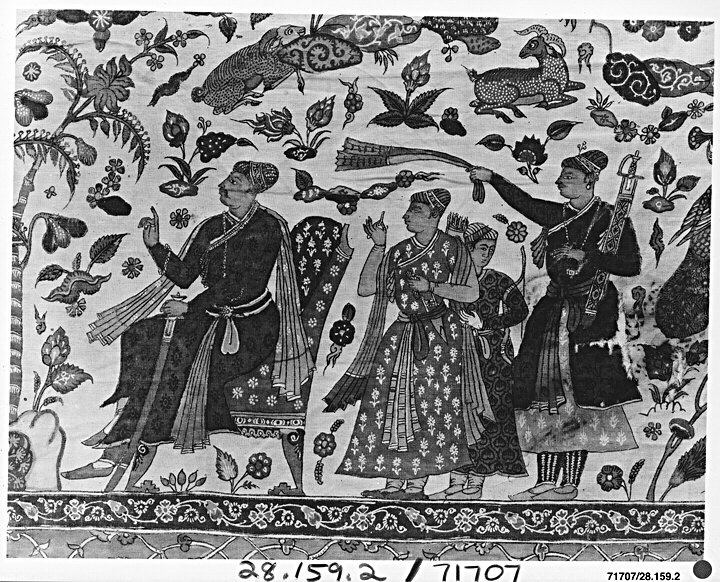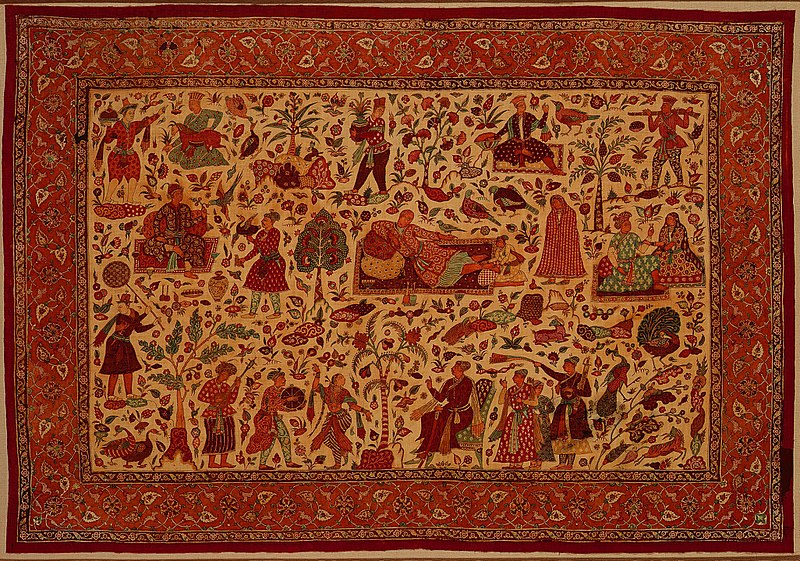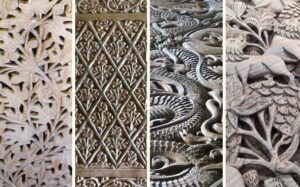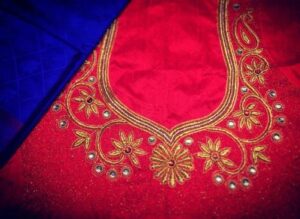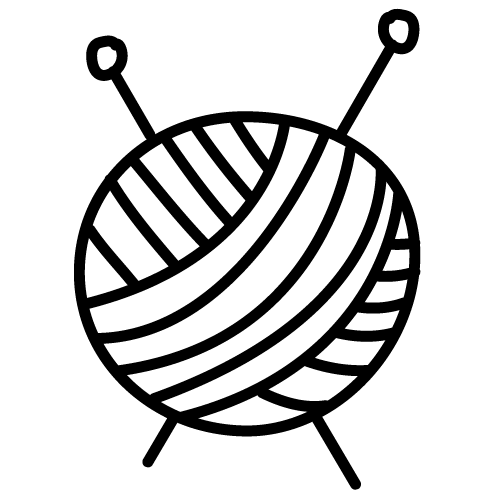Everything you need to know about
Kalamkari.
India has a rich and diverse history.
Even when looking at our geographical location, this country is filled with diverse people and hence different cultures and art.
Kalamkari is one such extremely exquisite art form of India.
What is Kalamkari?
Kalamkari is the art done on cotton textile through hand-painting of hand-block printing.
It refers to the antique style of hand painting that is done with a tamarind pen, using natural dyes.
The word Kalamkari breaks down into two parts, Kalam, which means pen and Kari which refers to craftsmanship.
This art form is very prominent in the Indian states of Andhra Pradesh and Telangana.
It specifically uses natural dyes and is done in twenty-three steps.
These detailed twenty-three steps involve dyeing, bleaching, hand painting, block-printing, starching, cleaning and more.
Kalamkari art involves various figures and motifs from Indian mythology and history.
Figures like lotus, peacock, divine figures from the Indian epics and most common in this artform.
This art is centuries old and still, it has managed to survive and thrive in this modern era.
Kalamkari is the true representation of coastal India.
It is the essence of both the history and development of India.
The craftsmen of this art are extremely skilled and have been carrying this skill from generations.
Art is about connections and that’s what Kalamkari does best.
Its narrative style speaks to its audience in a distinct and beautiful way. It connects our tradition with contemporary times flawlessly.
This ancient art form has now been evolved to be used in digital prints and modern clothing.
So, how did this journey from a long tedious artform to digital printing start?
Let’s find out.
What is the origin of Kalamkari?
The origin of Kalamkari lies in the ancient Indian practice of storytelling.
In ancient India, storytellers and painters used to travel from place to place to sing and narrate folktales.
Eventually, they started painting these narratives on clothes and canvases and Kalamkari was born.
This art form dates back to 3000 B.C.
Some archaeologists and historians have found remains of Kalamkari art on the sites of Mohenjo-Daro.
Kalamkari was originated back in ancient India but it got its recognition and name from the Mughals.
Mughals promoted this art in the Golconda and Coromandel region, where skilled craftsmen (known as Qalamkars) used to practice this art.
Under the Golconda sultanate, this art flourished at Machilipatnam in the Krishna district of Andhra Pradesh.
The Britishers further promoted Kalamkari in the 18th century as a textile design for Britishers living in India.
Even today, Kalamkari is a generational art in Andhra Pradesh.
It has been the livelihood of several families through generations
What are the different types of Kalamkari?
There are two variations of Kalamkari, Srikalahasti and Machilipatnam.
Let’s find out more about these distinct variations-
- Srikalahasti Kalamkari
This type of Kalamkari art draws inspiration from the Hindu mythology and scenes from epics and folklores.
It is more religious and originated in temples. - Machilipatnam Kalamkari
Motifs in this type of art are painted with hand-carved wooden blocks and the detailing is done by intricate hand painting.
Two other types of Kalamkari art have originated because of the geographical location they are practised in.
These locations provide all the necessities of the production.
The Gujarat Kalamkari draws inspirations from mythological characters of Krishna, Arjun, Ganesha, Buddha, etc.
The Andhra Kalamkari is inspired by forts, temples and architecture of ancient India and motifs of animals, birds and flowers.
How is Kalamkari art carried out?
As mentioned above, the process of making the Kalamkari involves 23 steps.
From the natural process of bleaching the fabric, softening it, sun drying, preparing natural dyes, hand painting, to the processes of air drying and washing, the entire procedure is a process which requires accuracy and an eye for detailing.
The fabric used in Kalamkari is first treated with a solution of cow dung and bleach.
This gives it a nice off-white colour.
After this bleaching treatment, the fabric is dipped into a solution of buffalo milk and Myrobalans.
This step avoids any smudging of paints and dyes.
This fabric is now washed 20 times and dried in the sun.
Once, the fabric is ready, artists start painting motifs and figures according to their vision and inspiration.
Artists use a tamarind twig as a pen.
This pen is dipped into various natural dyes and used to paint various figures and motifs of the Kalamkari art.
Wait, are you also thinking what are these natural dyes and how are they made?
What are the dyes used in Kalamkari?
All the dyes used in traditional Kalamkari are naturally obtained without any synthetic chemicals.
Kalamkari mainly uses earthy colours like brown, indigo, green, black, etc.
All these dyes are naturally obtained without any use of chemical substances.
Black dye is used for outlining sketches and motifs.
It is obtained by mixing jaggery, water and iron fillings.
Black dye forms the base of Kalamkari art.
Red dye is extracted from the bark of madder or aligirin while the blue dye is extracted from the indigo plant.
Yellow is obtained from boiling pomegranate seeds and green dye is made by mixing yellow and blue together.
All these basic and primary colours are used to make different shades and hues used in Kalamkari.
How is Kalamkari being evolved into digital prints?
Adapting for survival is the tactic to keep anything alive.
Same is the case with Kalamkari art.
It has been evolved into digital prints for easy manufacturing for the fast-fashion industry.
Due to this development, this ancient art has travelled and influenced fashion and design all over the world.
Many upcoming, as well as established designers and artists, are incorporating this artform into their designs.
Earlier, Kalamkari was an intricate art requiring skilled craftsmen and tools.
It was losing its influence due to its tedious traditional process.
Due to the emergence of fast-fashion and printed textiles, Kalamkari was diminishing into the margins.
However, with the emergence of printed Kalamkari, this art has been flourishing like never before.
The fashion industry helped revive Kalamkari and took ideas from the artisans from Gujarat and Andhra Pradesh.
Kalamkari sarees, suits, and other modern apparel are very popular among the youth.
This art is just not restricted to apparel, as many furnishing and decorative artefacts are created with Kalamkari art.
How are Kalamkari and sustainability inter-related?
As our planet has limited resources, sustainable products and lifestyles are promoted to avoid any exploitation.
You must have seen various brands “going green” and adopting sustainable products to help climate change and global warming.
Kalamkari art is becoming increasingly popular due to this demand and the need for sustainability.
As we saw above, this art is done by completely naturally extracted dyes.
This is extremely safe for the environment as it uses no chemicals or fuels in its process.
It uses natural products and processes like sunlight and milk to manufacture the final product.
Due to this sustainable nature of Kalamkari, more and more people are recognizing and supporting this ancient art of India.
Artisans of Kalamkari
We discussed above that Andhra Pradesh is the primary location and origin of Kalamkari Art.
The geographical location of this state is beneficial to Kalamkari art form.
The states surrounding Andhra Pradesh are the primary producers of cotton fabric, the basic canvas for Kalamkari.
Another advantage of this location is the abundance of the water source as Kalamkari art requires water for the initial steps.
The river Swarnmukhi provides abundant water to artists in Srikalahasti.
Machilipatnam has a canal that helps the kalamkari artists in acquiring water for their work.
The inspiration for this art form comes from the surrounding culture and social scenarios of the artisans.
The Srikalahasti Kalamkari art produces detailed and intricate designs. They have bold motifs outlined with black.
The Machilipatnam artform has more free following designs and motifs.
The Kalamkari Printers Welfare Association of Machilipatnam works with GIR Chennai to provide these artisans with copyright security.
They can register under trademark rights so that nobody can copy or take credit for their art in any way.
Art is a form of expression and Kalamkari defines it in the best way.
It originated from story-telling and now has developed into a fashion and design industry.
The progress of this art is as phenomenal as the artform itself.
While most of the ancient practices die with time, Kalamkari strives to evolve and move further.
The generational sustainable artisans of Kalamkari deserve all the recognition and support they can get.
This art has survived centuries of constant change.
This proves that it has the ability to connect with every generation. Kalamkari proves to be a perfect reminder of how our heritage and culture are essential to us.
We need to surround ourselves with our history and art to stay connected to our roots.
Money may give us success but art gives us solace.
Please comment down below if you have any suggestions and ideas about what we should cover next.
Did we miss something?
Let us know in the comments down below!




